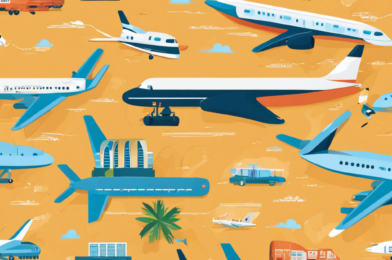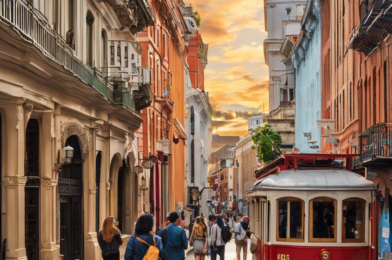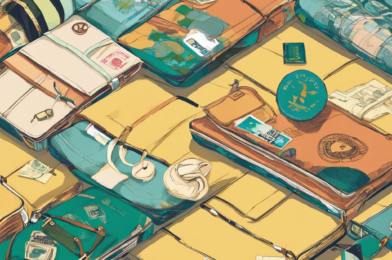Couchsurfing 101: Your Passport to the World
What is Couchsurfing?
Couchsurfing is a unique and incredible way to travel the world and experience new places and cultures without the usual hefty price tag. It’s a global community that connects travelers with locals who are willing to offer a free place to stay, whether it’s a spare bedroom, a cozy couch, or even just a spot on the floor. But it offers so much more than just a free bed for the night. Couchsurfing is about creating meaningful connections, cultural exchange, and embracing the adventure that comes with staying in a local home.
How Does it Work?
The concept is simple. Travelers create a profile on Couchsurfing platforms, such as Couchsurfing.com or BeWelcome, detailing their interests, travel plans, and any skills or experiences they can share with hosts. They then search for potential hosts in their desired locations, send requests, and await a response. Hosts, who are often seasoned travelers themselves, offer a place to stay, sometimes even providing insider tips and local experiences to their guests.
Where Can You Go?
The beauty of Couchsurfing is that it spans the globe. From bustling cities to quaint rural villages, chances are there’s a host nearby. Whether you’re dreaming of wandering the streets of Paris, exploring the ancient ruins of Rome, or discovering the lush rainforests of Costa Rica, Couchsurfing can make it happen. With hosts in over 200,000 cities across the globe, the world truly becomes your oyster.
Who Are the Hosts?
Couchsurfing hosts are everyday people with a passion for travel and a desire to connect with others. They come from all walks of life, backgrounds, and age groups. Some are young adventurers eager to meet new people, while others are retirees who love sharing stories and experiences. Many hosts are eager to show off the best their city has to offer, taking guests on local tours and introducing them to hidden gems that only locals know about.
What’s in It for the Hosts?
You may wonder why someone would open their home to strangers for free. Well, it’s about much more than a free bed. Hosts gain cultural exchange, new friendships, and the joy of giving back to the travel community. Many hosts have traveled extensively themselves and understand the value of a friendly face in a new place. They often enjoy sharing their local knowledge, favorite spots, and even home-cooked meals with their guests. It’s a rewarding experience that creates lifelong memories and connections.
Is It Safe?
Couchsurfing platforms prioritize safety and offer various tools to ensure a secure experience. Travelers and hosts alike create detailed profiles, verify personal information, and receive references from previous hosts and guests. These references provide valuable insights into the reliability and trustworthiness of potential guests and hosts. Additionally, Couchsurfing platforms offer 24/7 support and resources to promote safe and positive experiences.
Beyond a Free Bed
Couchsurfing offers a unique perspective on travel that goes beyond just a place to sleep. It’s about embracing the local culture, making lasting connections, and gaining insider knowledge. Many hosts enjoy showing their guests around, introducing them to local customs and traditions, and even joining them on adventures. It’s not uncommon for guests to be invited to family dinners, local festivals, or hidden hiking trails known only to residents.
How to Be a Great Guest
Being a great Couchsurfing guest is all about respect, gratitude, and reciprocity. Respect your host’s space, privacy, and rules. Show your gratitude for their hospitality, whether through a small gift, a home-cooked meal, or a simple heartfelt thank you. Reciprocate their kindness by offering your skills or experiences, whether that’s teaching them a new language, sharing stories from your culture, or offering a travel tip or two.
How to Find the Right Host
Finding the perfect Couchsurfing host is a bit like dating. Take the time to read through profiles, looking for shared interests, values, and expectations. Send personalized requests, detailing why you’re visiting, what you hope to gain from the experience, and how you think you’ll fit into their household dynamic. Be honest, open, and respectful, and you’re sure to find a host who’s the perfect match.
When to Send Requests
Timing is everything when it comes to sending Couchsurfing requests. It’s best to start planning and reaching out to potential hosts a few months in advance, especially if you’re aiming for a popular destination or during peak travel season. This gives hosts time to get to know you and plan their availability. However, last-minute requests can also be successful, especially if you’re flexible and open to different types of accommodations.
What to Pack
When Couchsurfing, it’s important to travel light. Remember, you’ll likely be staying in people’s homes, so pack as you would if you were a guest at a friend’s house. Bring a small gift from your home country or something unique from your hometown to offer your host as a token of your appreciation. Other than that, pack the essentials, but remember you can always buy things you might need along the way.
Embracing the Adventure
Couchsurfing is all about embracing the unexpected. Be open to new experiences, last-minute changes, and the unique opportunities that arise when you step into someone’s home. Your host might invite you to a local event, suggest an impulsive road trip, or introduce you to a delicious but unfamiliar cuisine. Say yes to these adventures (within reason, of course!), and you’ll create memories that will last a lifetime.
Making Lifelong Connections
One of the most beautiful aspects of Couchsurfing is the potential to forge lifelong connections. The hosts you stay with and the fellow travelers you meet along the way can become friends for life. These are people with whom you’ve shared unique experiences, deep conversations, and perhaps even life-changing adventures. Stay in touch, follow each other’s journeys, and who knows, you may end up hosting them in your home one day!
Couchsurfing is built on a foundation of community and reciprocity. Once you’ve experienced the warmth and generosity of the Couchsurfing world, it’s essential to give back. Consider becoming a host yourself, paying it forward by offering your spare room or couch to weary travelers. Even if you can’t host, you can still contribute by sharing your local knowledge, organizing events or gatherings, or simply being an ambassador for the CouchsurMultiplier effect, where one good turn leads to another, and the Couchsurfing community thrives and grows through the collective efforts and generosity of its members.
Expanding Your Horizons
Couchsurfing isn’t just about finding a free place to stay; it’s about expanding your horizons and embracing new perspectives. By staying with locals, you gain insight into their daily lives, customs, and traditions. You’ll find yourself immersed in conversations about politics, culture, and history, learning more in one evening than you could from any guidebook. Couchsurfing pushes you beyond your comfort zone and challenges your assumptions, leaving you with a broader worldview and a deeper understanding of the human experience.
Overcoming Language Barriers
One of the beautiful challenges of Couchsurfing is navigating language barriers. While many hosts speak English, you may encounter those who don’t, or whose fluency varies. Embrace this as an opportunity to learn a few phrases in their language and communicate through gestures, expressions, and the universal language of a warm smile. These interactions often lead to hilarious misunderstandings, surprising connections, and a newfound appreciation for the beauty of different tongues.
The Gift of Sharing Stories
Couchsurfing brings together people from all walks of life, each with their own unique story to tell. As you gather around the dinner table or curl up on the couch with your host and fellow travelers, take the time to share your stories. Talk about your dreams, your challenges, and the adventures that led you to this very moment. In doing so, you’ll create a sense of camaraderie and understanding that transcends borders and backgrounds. These shared stories become the threads that weave the Couchsurfing community together.
Leaving a Positive Impact
As a Couchsurfing guest, you have the power to leave a lasting, positive impact on the people you meet and the places you visit. Respect your host’s home and culture, be mindful of your surroundings, and always leave a place better than you found it. This could be through a simple gesture, like doing the dishes or leaving a handwritten note, or something more significant, like volunteering your time or skills to a local cause. Remember, you are an ambassador for both the Couchsurfing community and your home country.
The Magic of Couchsurfing
There’s a certain magic that happens when you enter someone’s home as a stranger and leave as a friend. It’s the magic of shared meals, laughter-filled conversations, and the unspoken bond that forms when you step into someone’s life for a fleeting moment. Couchsurfing is more than just a way to travel; it’s a movement that connects people across borders, bridges cultural gaps, and fosters understanding. It’s a reminder that, despite our differences, we are all citizens of the same world, and that our similarities far outweigh our distinctions.
So, to all the wanderers, adventurers, and dreamers, embrace the world of Couchsurfing and let it carry you to new places, new friendships, and a deeper understanding of the beauty that exists in our diverse and captivating world.









